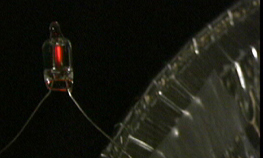|
Electric Forces
|
|
|
| Seat Experiment |
|
The electrophorus was invented in 1762 by Johan Carl Wilcke and perfected by Alessandro Volta in 1775, but widely promoted and made famous by 18th century American physicist and political activist Benjamin Franklin. Franklin constructed his device with wood, sulfur, wax and pewter. Our electrophorus is constructed from an Aluminum pie pan, a Styrofoam plate and cup, some tape and a small Neon bulb. |
| Construct an electrophorus by taping the Styrofoam cup to the center of a pie pan. Separate the leads of the Neon bulb and tape one end to the edge of the pie pan. The Neon bulb will clearly glow at 65V - 90V, readily indicating typical static electric charges. |
|
| Charge the Styrofoam plate be rubbing in against your hair and them place it on the table. Holding the pie pan with its handle (Styrofoam cup), place it on top of the plate. Be careful not to touch the Aluminum with your hand. Touch the outer wire of the Neon bulb with your finger. You should draw a spark and light the bulb. |
| Now pick up the Al plate by the insulating handle, and again touch your finger to the outer wire of the Neon bulb. The light should again glow. Repeat the down-touch, up-touch cycle several times with your partners. |  |
| Q1:
The original source of charge for the electrophorus is the charged
Styrofoam plate. How does this charge come about? What is the
sign of this charge? (Hint: here is a list of triboelectronegativities that will help determine the sign of the charge on the Styrofoam plate.) Q2: Describe the flow of electrons to or from the Al plate when it is DOWN on top of the Styrofoam plate and the bulb is touched. Draw a diagram indicating charge distributions before and after the hand contacts the bulb. Q3: Again describe what happens to electrons when the Al plate is raised in the air and again touched. Again diagram the charge distribution before and after contact. How is the up-in-the-air situation different? Q4: Closely examine the Ne bulb during the down-touch, up-touch cycle. Only one side of the NE bulb SHOULD glow at a time, and this should change depending on whether the Al plate is up or down. Which side (most positive or most negative) glows? Q5: The down-touch, up-touch cycle can be repeated almost indefinitely or until the Styrofoam charge leaks away. Since the charge on the Styrofoam is not "used up," where does the energy to light the bulb repeatedly come from in this device? Q6: Write a complete description of how the electrophorus works. Use your description to provide examples to define and explain charge transfer by friction, contact and induction. Advanced Question: Arizona gas pumps have a sticker on them as shown. Explain why.
|
| References |
| This device and many other similar devices is described in : Morse, R.A. (1992). Teaching About Electrostatics: An AAPT/PTRA-plus Workshop Manual, AAPT: College Park MD. |
|
|
|
|